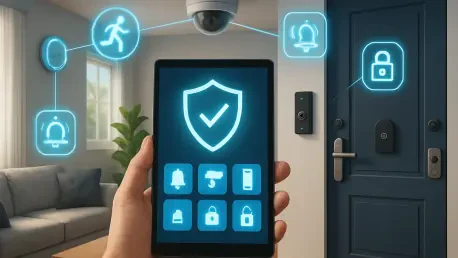In an era where home security is increasingly intertwined with smart technology, finding a system that balances robust protection with modern convenience is a challenge many homeowners face. Imagine returning from a long day to find your home safe, not just from intruders but also from environmental hazards like leaks or fires, all monitored in real-time by professionals. ADT, a name synonymous with home security for decades, steps into this space with its Smart Home Security System, promising a blend of traditional safeguards and cutting-edge features. This offering aims to provide peace of mind through comprehensive threat detection and professional oversight, while also dipping into the realm of smart home automation. However, as the market grows more competitive, questions arise about whether this system can truly meet the diverse needs of today’s tech-savvy consumers. Delving into its core strengths, such as reliable security measures and installation flexibility, alongside its shortcomings in smart home integration, offers a clearer picture of its standing. This exploration seeks to unpack the nuances of what makes ADT a contender, and where it might leave potential buyers wanting more.
Unwavering Focus on Security
The foundation of ADT’s Smart Home Security System lies in its commitment to safeguarding homes with a security-first approach that prioritizes the well-being of residents above all else. At the heart of this setup is the ADT Base, a central hub equipped with advanced connectivity options like Wi-Fi, LTE, and Z-Wave radios to ensure seamless operation across various devices. This hub not only features a numeric keypad for easy arming and disarming but also includes a backup battery to maintain functionality during power outages for up to 24 hours. The inclusion of an LTE radio guarantees that contact with the monitoring center remains intact even if the primary internet connection fails. Beyond the hub, the system encompasses a wide range of sensors designed to detect multiple threats, from door and window breaches to motion within the home, ensuring that no corner is left unprotected. This comprehensive suite of components reflects ADT’s long-standing expertise in creating environments where safety is paramount, catering to those who value reliability over flashy add-ons.
Complementing the hardware is an array of specialized sensors that elevate the system’s ability to respond to diverse dangers with precision and efficiency. Motion sensors, for instance, are engineered to be pet-friendly, ignoring animals weighing less than 85 pounds to minimize false alarms that could disrupt daily life. Glass-break sensors offer coverage ranging from 2 to 25 feet, adept at detecting window breaches that might signal an intrusion. Additionally, environmental sensors for smoke, carbon monoxide, and water or temperature changes provide an extra layer of protection against non-intruder threats that could devastate a home. These elements collectively create a robust network of defense, addressing both physical security and life-safety concerns with equal diligence. For homeowners seeking a system where protection isn’t compromised by unnecessary complexity, this focus on core security features stands as a compelling reason to consider ADT’s offering in a crowded market.
The Pillar of Professional Monitoring
A defining characteristic of ADT’s Smart Home Security System is its mandatory 24/7 professional monitoring service, which serves as a cornerstone of the peace of mind it promises to deliver. This feature ensures that trained staff are always on standby, ready to respond the moment an alarm is triggered, whether it’s due to a potential break-in or an environmental hazard. Upon detection, the monitoring center promptly contacts the homeowner to verify the situation, reducing the likelihood of unnecessary dispatches while ensuring genuine emergencies are addressed swiftly. If confirmation of a threat is established or contact cannot be made, first responders are sent to the location without delay. This constant oversight is particularly valuable for those who are frequently away from home or unable to manage alerts personally, providing a safety net that few competitors can match in terms of reliability and immediacy.
However, this high level of service comes with a financial commitment that potential buyers must carefully evaluate before opting in. The mandatory nature of the monitoring means that monthly fees are unavoidable, starting at a baseline and increasing with additional features or service plans. These costs, while justified by the comprehensive protection offered, can add up over time, especially when paired with long-term contracts that lock users in for extended periods. For some, this expense is a worthwhile trade-off for the assurance of professional intervention at any hour. Yet, for budget-conscious individuals, the ongoing fees might pose a barrier, prompting a comparison with systems that offer optional or self-monitoring alternatives. Understanding this balance between cost and benefit is crucial for anyone considering ADT as their security provider, as it directly impacts the overall value derived from the system.
Flexibility in Installation Choices
One of the standout aspects of ADT’s Smart Home Security System is the flexibility it offers in installation, catering to a spectrum of consumer preferences and financial considerations with equal attention. For those comfortable with a hands-on approach, the DIY option presents a significant opportunity to save on upfront costs, a choice that, while only adopted by about 10% of customers, is supported by a wealth of resources. ADT provides detailed tech support articles, instructional videos, and even real-time video assistance to guide self-installers through the process of setting up their system. This accessibility empowers tech-savvy individuals or those on a tighter budget to take control of their home security setup without sacrificing quality or functionality. The ability to bypass professional fees while still accessing a robust system highlights ADT’s adaptability to varying user needs in a market that often leans toward mandatory professional services.
In contrast, the option for professional installation appeals to those who prefer a seamless, hassle-free experience or lack the time and expertise for a DIY setup. This service, while ensuring that every component is correctly placed and optimized, comes at a considerable cost, with fees for a 20-component system reaching up to $1,300 depending on complexity and location. Additional local expenses, such as municipal alarm permits, may also apply and are not covered in the quoted price, adding another layer of financial planning for buyers. While the expense might deter some, the assurance of expert installation can be invaluable for ensuring the system operates at peak efficiency from day one. This dual approach to installation underscores ADT’s recognition that different households have different priorities, offering a tailored path to security regardless of whether one chooses to save money or invest in professional precision.
Navigating the Cost Structure
Understanding the full financial implications of adopting ADT’s Smart Home Security System is essential for any prospective buyer, as costs are multifaceted and span both initial and recurring expenses. Upfront, the hardware itself starts with the ADT Base at $249, a central piece that anchors the system’s functionality. Additional devices, such as basic door and window sensors, can be as affordable as $20, while more advanced components like smart locks with fingerprint recognition reach nearly $300. For a comprehensive setup, these costs can accumulate quickly, especially when factoring in professional installation fees that vary based on the number and type of devices. Beyond the initial outlay, potential buyers must also account for ancillary expenses like local permits, which are often overlooked but can impact the total investment required to get the system up and running effectively.
On top of the upfront costs, the ongoing monthly fees represent a significant commitment that shapes the long-term affordability of ADT’s offering. Basic intrusion monitoring starts at $24.99 per month, a figure that can escalate to $63.99 when including premium services like smart home automation and video verification through integrated subscriptions. These fees are tied to mandatory professional monitoring, ensuring 24/7 oversight, but they also come with contracts that typically span multiple years, with penalties for early termination. This structure necessitates careful budgeting, as the cumulative cost over time may outweigh the initial appeal of robust security for some households. Comparing these expenses with competitors who might offer more flexible payment plans or self-monitoring options becomes a critical step for anyone weighing the value of ADT’s comprehensive protection against their financial constraints.
Smart Home Capabilities and Partnerships
ADT’s Smart Home Security System extends beyond traditional security by incorporating smart home features through a strategic partnership with Google, enhancing functionality with modern conveniences. This collaboration brings integration with Google Nest products, such as indoor cameras, video doorbells, and floodlight-equipped cameras, into the fold, offering capabilities like facial recognition and the ability to differentiate between people, pets, and vehicles. These additions not only bolster security by providing detailed surveillance but also add a layer of convenience for homeowners looking to automate aspects of their daily routines. The ADT Base’s inclusion of a Z-Wave radio further expands this potential, enabling compatibility with a range of third-party smart devices like plugs and light bulbs, provided they are not security-related, thus allowing for a customizable smart home experience within certain boundaries.
Despite these advancements, the smart home integration presents challenges that can affect the overall user experience and satisfaction with the system. A significant drawback is the necessity of using two separate applications—ADT’s own app for general system control and the Google Home app for detailed camera settings and features like facial recognition. This dual-app requirement creates a fragmented interface, which can be cumbersome compared to competitors offering a single, unified platform for all functionalities. While the ability to set up automation rules within the ADT app—similar to trigger-based routines—adds value, the lack of seamlessness in managing connected devices may frustrate users seeking a more cohesive smart home ecosystem. This aspect highlights a key area where ADT’s system, while innovative in parts, struggles to match the polished integration seen in some alternative offerings on the market.
Challenges in Ecosystem Compatibility
While ADT’s Smart Home Security System offers notable smart home features, it falls short in providing broad ecosystem compatibility, which could be a limiting factor for many potential users. A prominent issue is the absence of support for Amazon Alexa, a widely used platform that powers countless smart homes across the country. This exclusion means that individuals already invested in Alexa-enabled devices or routines will find themselves unable to integrate their existing setup with ADT’s system, potentially necessitating a complete overhaul of their smart home infrastructure. Given the popularity of Alexa, this limitation narrows the system’s appeal, particularly for tech enthusiasts or households that prioritize interoperability across diverse platforms over brand-specific integrations.
Further compounding the challenge is the fragmented user experience stemming from the system’s tight alignment with Google’s ecosystem, which, while beneficial for Nest users, introduces operational hurdles. The reliance on both the ADT app and the Google Home app for full control over connected devices and advanced features disrupts the fluidity that many expect from a modern smart home solution. For instance, accessing detailed surveillance settings or managing facial recognition data requires toggling between apps, a process that can feel disjointed and time-consuming. This lack of a unified interface stands in contrast to competitors who have streamlined their systems into a single point of control, potentially deterring buyers who value simplicity and efficiency in their smart home interactions. Addressing these compatibility and usability gaps could significantly enhance ADT’s position in a market increasingly driven by seamless connectivity.
Standout Innovations for User Convenience
ADT’s Smart Home Security System distinguishes itself with unique features designed to enhance user convenience and community-based safety, setting it apart from many competitors in the field. One such innovation is the “Trusted Neighbor” functionality, which allows homeowners to designate specific contacts who can receive notifications about home events—such as package deliveries or detected leaks—when the system is in Armed Away mode. These trusted individuals can then access the property to address issues, offering a practical solution for managing a home during extended absences. This feature not only fosters a sense of community support but also provides an additional layer of security and responsiveness that is rare in the industry, making it a noteworthy selling point for those who value such collaborative protection strategies.
Beyond this, the system supports a sophisticated structure of user access levels, catering to diverse household dynamics with tailored control options. Categories such as Family (with Admin, Standard, and Basic roles), Helpers & Guests, and Trusted Neighbors allow for granular permissions, ensuring that each user has appropriate access based on their relationship to the homeowner. For instance, Admins can wield full control, including setting up emergency duress codes that silently alert monitoring staff, while temporary guests might have scheduled access for specific needs. This tiered approach enhances the system’s adaptability, accommodating everything from daily family routines to occasional visitor needs. Such thoughtful design in user management underscores ADT’s commitment to creating a security solution that fits seamlessly into varied lifestyles, adding significant value for those with complex household arrangements.
Reflecting on ADT’s Market Position
Looking back, the journey through ADT’s Smart Home Security System reveals a solution deeply rooted in traditional security excellence, bolstered by mandatory professional monitoring and a comprehensive array of sensors that leave little room for vulnerability. The flexibility of installation options, whether through cost-saving DIY routes or expert-led setups, caters to a broad audience, while innovative touches like the Trusted Neighbor feature showcase a forward-thinking approach to community safety. Yet, the system’s foray into smart home territory is met with hurdles, particularly in the fragmented app experience and the absence of broader ecosystem support, which temper its appeal for tech-driven users.
Moving forward, potential buyers would benefit from weighing these strengths against the identified limitations to determine if ADT aligns with their specific security and smart home aspirations. A practical next step involves a detailed cost-benefit analysis, considering both upfront investments and ongoing fees against the backdrop of personal budget constraints. Exploring competitor offerings with more seamless integrations or flexible monitoring plans could provide valuable context for decision-making. Additionally, for those intrigued by the system’s unique features, engaging with ADT’s support resources to fully understand customization options might unlock tailored solutions. Ultimately, the path to choosing a home security system lies in aligning robust protection with individual lifestyle needs, ensuring that safety and convenience coexist in harmony for the long term.









